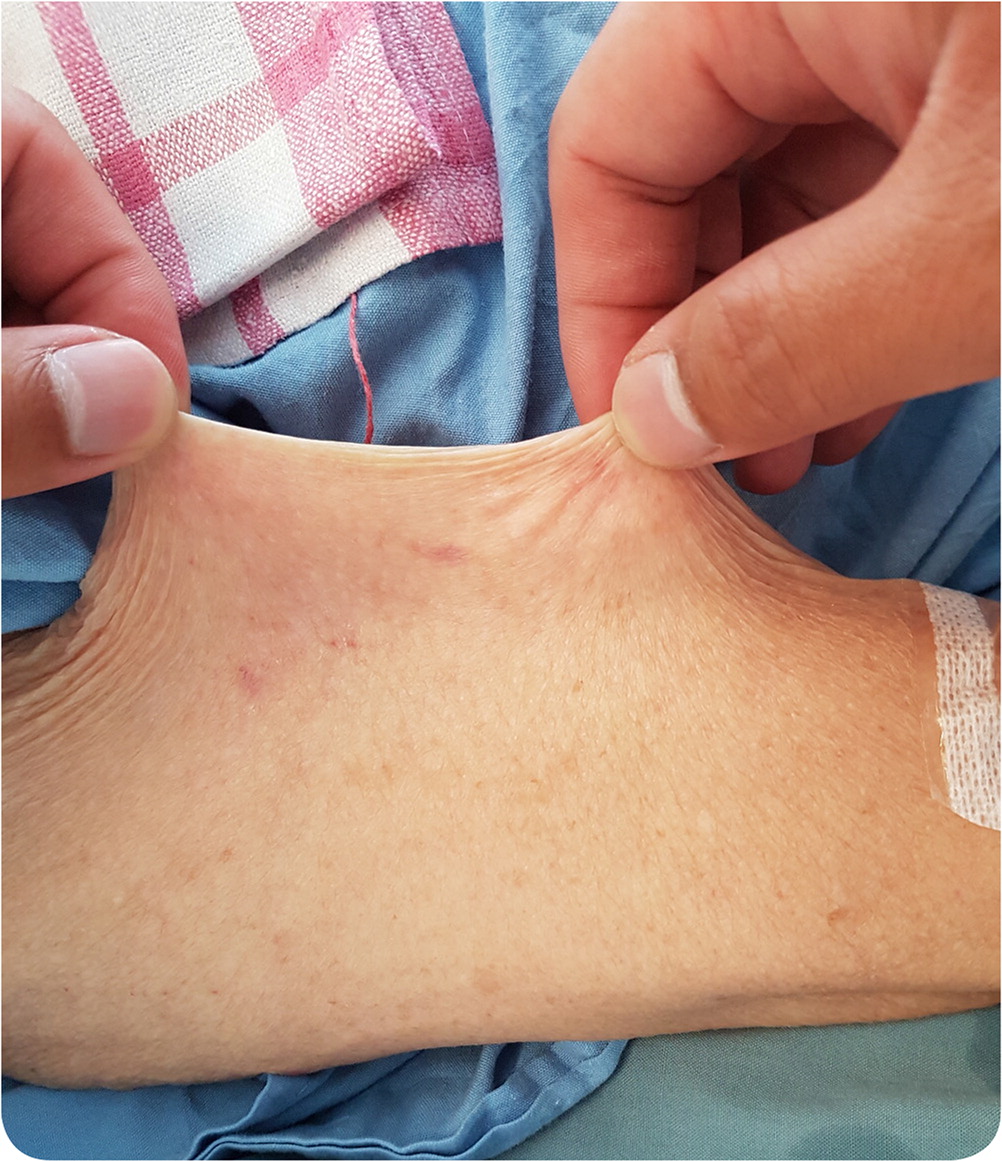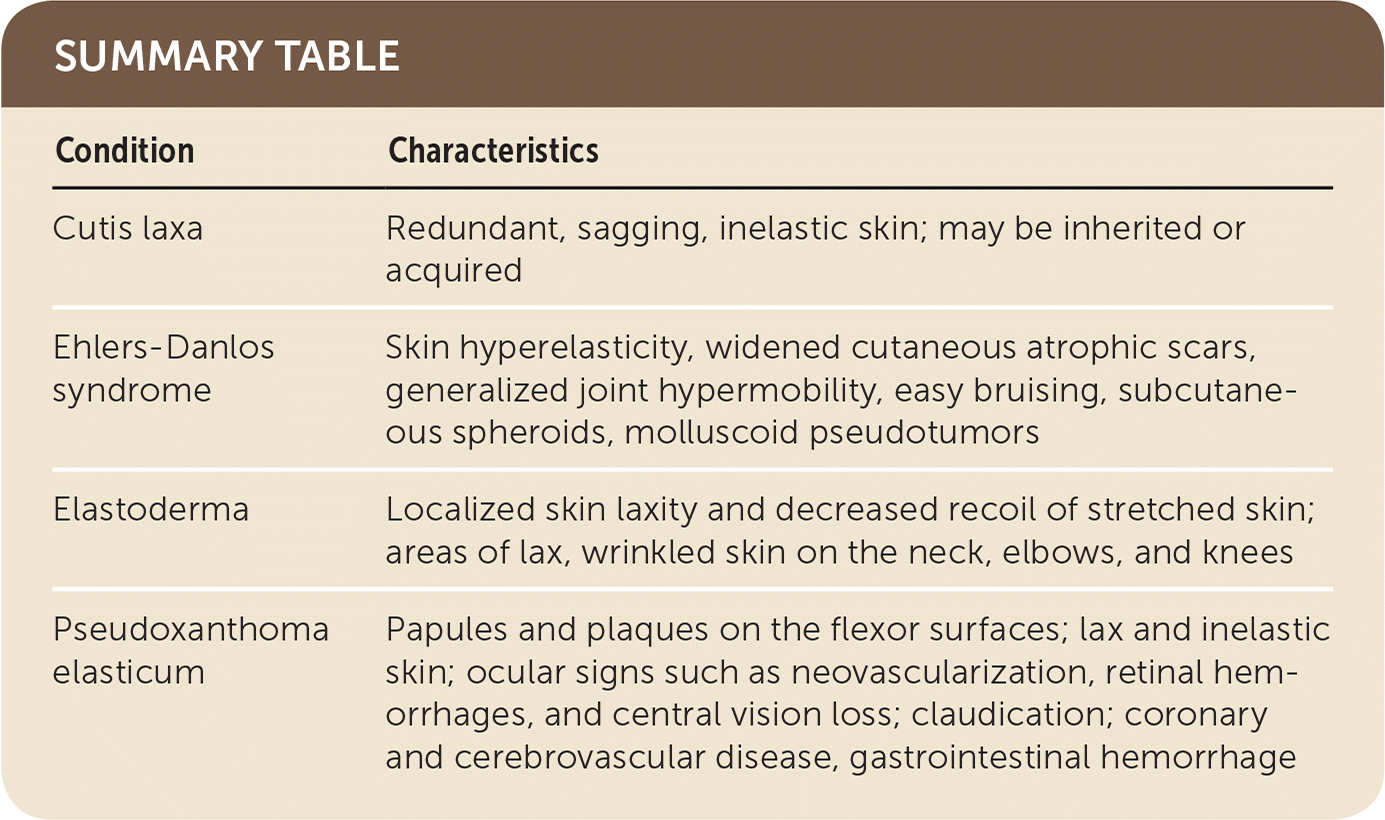
Am Fam Physician. 2018;97(10):673-674
Author disclosure: No relevant financial affiliations.
A 65-year-old woman was admitted to the hospital with a left elbow fracture after a fall. She had a history of recurrent joint dislocations since childhood and orthopedic procedures on several joints. When she was younger, she could rest her palms on the floor in a standing position while flexing the trunk forward with knees fully extended.
On physical examination, the patient was in no acute distress other than pain in her elbow. She could touch her forearm with passive flexion of her right thumb. Hyperelasticity of the skin (Figure 1) was noted.

Question
Discussion
The answer is B: Ehlers-Danlos syndrome. This syndrome encompasses a group of distinct inherited connective tissue disorders.1 Marked skin hyperelasticity, widened cutaneous atrophic scars, and generalized joint hypermobility are features of classic Ehlers-Danlos syndrome. Easy bruising, subcutaneous spheroids, and molluscoid pseudotumors may also occur.
In the vascular form of Ehlers-Danlos syndrome, the skin is thin and translucent with visible underlying vessels, but not hyperelastic. Possible complications of vascular Ehlers-Danlos syndrome include aortic dissection, rupture, and aneurysms.2 Other forms of the syndrome are hypermobile, kyphoscoliotic, arthrochalasic, cardiovalvular, myopathic, periodontal, musculocontractural, dermatosparactic, and brittle cornea syndrome. Kyphoscoliotic Ehlers-Danlos syndrome is an autosomal recessive condition, whereas the other forms are autosomal dominant.
Management of Ehlers-Danlos syndrome is multidisciplinary, involving cardiologists, rheumatologists, orthopedic and plastic surgeons, physiotherapists, and occupational therapists. Management should include avoidance of contact sports, as well as counseling the patient about healthy lifestyle choices and providing information to the family and school or employer about precautions and emergency medical treatment.
Cutis laxa is characterized by redundant, sagging, inelastic skin. It may be inherited or acquired. It can be inherited in an autosomal dominant, autosomal recessive, or X-linked recessive pattern. Multiple organs may be involved in the inherited forms.3
Elastoderma is a rare skin condition presenting as localized skin laxity and decreased recoil of stretched skin. Areas of lax, wrinkled skin occur on the neck, elbows, and knees. It typically occurs in young adults.4
Pseudoxanthoma elasticum is a genetic disorder affecting the skin, eyes, and cardiovascular system. Papules and plaques form on the flexor surfaces, and the skin becomes lax and inelastic. Ocular signs include neovascularization, retinal hemorrhages, and central vision loss. Claudication, coronary and cerebrovascular disease, and gastrointestinal hemorrhage may also occur.5

| Condition | Characteristics |
|---|---|
| Cutis laxa | Redundant, sagging, inelastic skin; may be inherited or acquired |
| Ehlers-Danlos syndrome | Skin hyperelasticity, widened cutaneous atrophic scars, generalized joint hypermobility, easy bruising, subcutaneous spheroids, molluscoid pseudotumors |
| Elastoderma | Localized skin laxity and decreased recoil of stretched skin; areas of lax, wrinkled skin on the neck, elbows, and knees |
| Pseudoxanthoma elasticum | Papules and plaques on the flexor surfaces; lax and inelastic skin; ocular signs such as neovascularization, retinal hemorrhages, and central vision loss; claudication; coronary and cerebrovascular disease, gastrointestinal hemorrhage |
